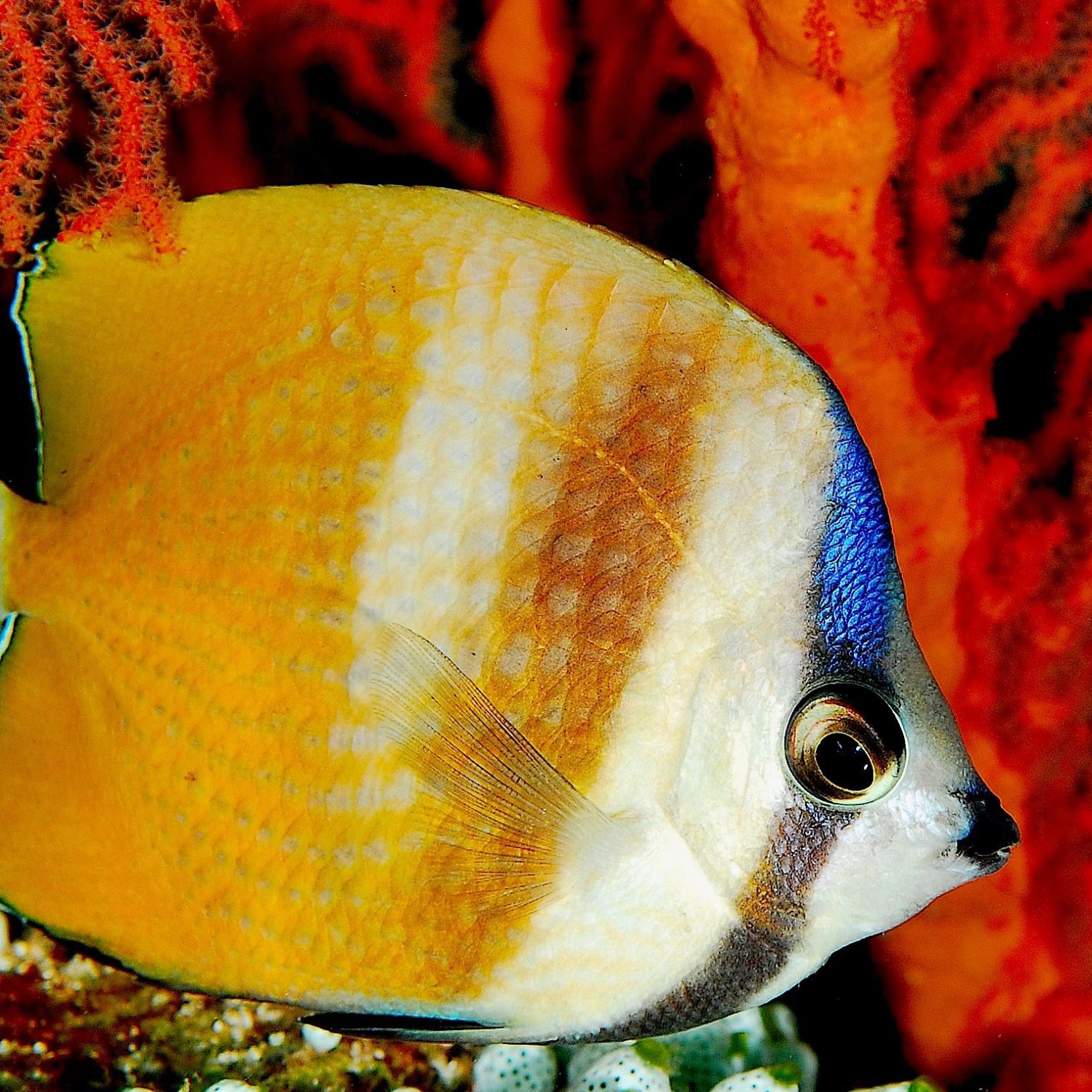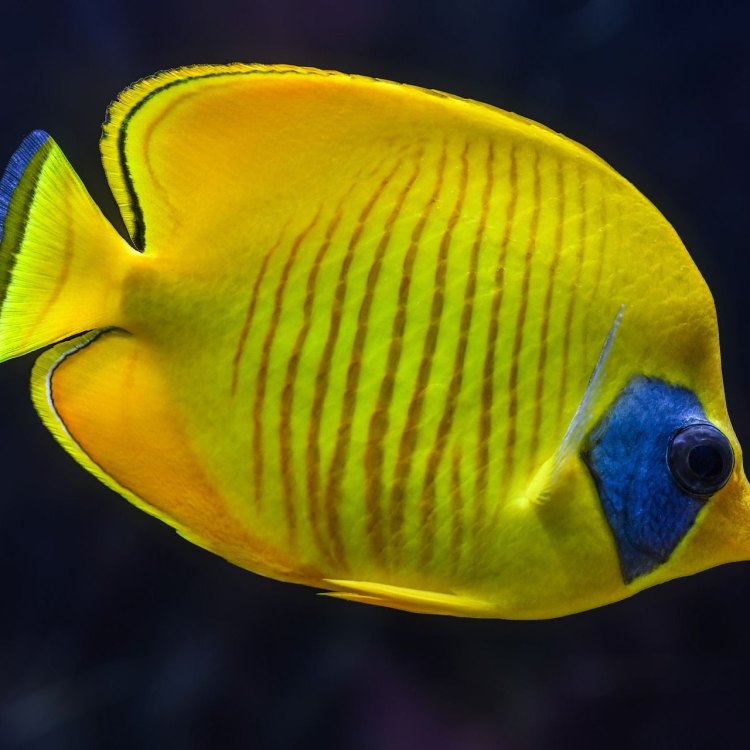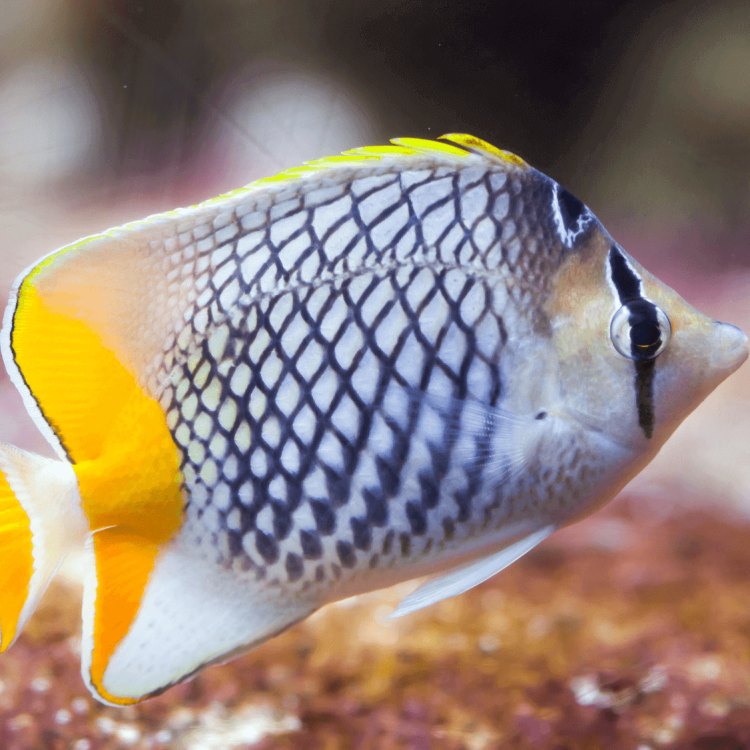
Butterfly Fish
2 to 9 inches (5 to 23 cm)
Butterfly Fish are colorful creatures found in coral reefs around the world. They belong to the Chaetodontidae family and come in a wide range of sizes, from 2 to 9 inches long. With their flattened and oval-shaped bodies, they are easy to spot among the vibrant corals. Keep an eye out for these beautiful fish on your next underwater adventure! #butterflyfish #coralreefs #oceanlife #chaetodontidae
Animal Details Summary:
Common Name: Butterfly Fish
Kingdom: Animalia
Habitat: Coral reefs and rocky coastlines
The Vibrant World of Butterfly Fish: A Guide to the Flora and Fauna of Coral Reefs
Imagine yourself diving into the crystal-clear waters of a tropical paradise. As you descend further into the ocean, the sunlight dances through the water, revealing a colorful and diverse world below the surface. Suddenly, you spot a flash of vibrant colors and unique patterns – a butterfly fish gracefully swimming through the coral reef. Known for their striking appearance and intriguing behavior, butterfly fish are some of the most beloved and sought-after species in the marine world Butterfly Fish. In this article, we will take a closer look at the fascinating world of butterfly fish, their natural habitat, and their incredible features.The Butterfly Fish Family
Butterfly fish belong to the scientific family Chaetodontidae. This family includes over 100 species of fish, all of which share similar physical characteristics. They are classified under the Kingdom Animalia, Phylum Chordata, and Class Actinopterygii. Being part of the order Perciformes, butterfly fish have a close genetic relationship with other popular tropical fish, such as angelfish and wrasses.A Habitat of Beauty and Diversity
Butterfly fish are found in the warm, tropical and subtropical waters of the Atlantic, Indian, and Pacific Oceans. These regions are known for their stunning coral reefs, which serve as the perfect habitat for these colorful creatures. Butterfly fish are predominantly found in shallow waters, at depths of up to 50 meters. They often prefer areas with strong currents and rocky coastlines, as they provide plenty of nooks and crannies for the fish to hide and seek shelter in Barnacle.Food for Thought: An Omnivorous Diet
Being omnivorous, butterfly fish have a diverse diet that includes both plants and small animals. Their main source of food is algae and coral polyps. They also feed on small crustaceans, such as shrimps and crabs, and various species of worms. Thanks to their unique and specialized beak-like mouths, butterfly fish are able to nibble on hard coral and extract their food from the crevices of the reef.Around the World in Vibrant Colors
One of the most striking features of butterfly fish is their coloration. With their vibrant and bold patterns, they are often referred to as the “birds of the sea”. Each species of butterfly fish has a distinct coloration, making them easily distinguishable from one another. Most commonly, they showcase vivid yellows, oranges, blues, and blacks, with intricate markings and stripes on their bodies.Butterfly fish also have unique eyes. They have a spot on their heads called the "false eye", which is meant to confuse potential predators. This “eye” tricks predators into attacking the wrong end of the fish, giving the butterfly fish a chance to escape.
A Flattened and Oval-Shaped Body
Butterfly fish have a distinctive body shape, which sets them apart from other fish species. They have a flattened and oval-shaped body, with small fins at the top and bottom and a larger fin at the back for propulsion. This shape helps them navigate easily through the coral reef and provides them with excellent maneuvering abilities, allowing them to dart quickly through tight spaces and avoid predators.Size Does Matter: How Big Can Butterfly Fish Grow?
Butterfly fish come in a variety of sizes, with the smallest species reaching only 2 inches (5 cm) in length and the larger species growing up to 9 inches (23 cm). These fish may seem small, but they are incredibly agile and fast swimmers. They have a streamlined body and powerful fins, which allow them to easily glide through the water and escape danger.The Secret to a Long Life: Average Lifespan of Butterfly Fish
The lifespan of butterfly fish varies depending on the species and their environment. On average, they can live anywhere from 5 to 10 years. However, in captivity, some species have been known to live up to 20 years. The key to a long life for these colorful creatures lies in the health of their coral reef habitat. With the right conditions, butterfly fish can thrive and live a full and healthy life.Butterfly Fish Around the World: Country of Origin
Butterfly fish are truly global citizens, with various species found in different parts of the world. They are native to the tropical and subtropical regions of the Atlantic, Indian, and Pacific Oceans, with some species found in specific countries, such as Indonesia, Australia, and the Maldives. However, due to their popularity among collectors, some species have been introduced into new areas, causing potential disruption to the natural balance of these marine ecosystems.The Importance of Coral Reefs
Butterfly fish are not just beautiful creatures; they also play a vital role in the health and survival of coral reefs. As they feed on algae and other harmful organisms, they help maintain the delicate balance of the coral reef ecosystem. Additionally, their waste serves as nutrients for the coral, helping them grow and stay healthy. Without butterfly fish, coral reefs may become overgrown and overrun by algae, posing a threat to its survival.Threats to Butterfly Fish
Unfortunately, butterfly fish populations are facing numerous threats. The destruction of coral reefs, due to factors such as climate change, pollution, and overfishing, is one of the main causes of their declining population. As their habitats are destroyed, butterfly fish are forced to seek out new areas, leading to increased competition and inbreeding.Additionally, butterfly fish are often targeted by the aquarium trade due to their stunning appearance. This further contributes to their declining numbers. It is important to remember that these beautiful creatures are not meant to live in captivity and should be enjoyed in their natural habitat.
Conservation Efforts
Conservation efforts are crucial in protecting butterfly fish and their habitats. Organizations such as the World Wildlife Fund (WWF) and the International Union for Conservation of Nature (IUCN) are working towards preserving and restoring coral reefs, and in turn, the creatures that call them home.There are also steps we can take as individuals to help protect butterfly fish. By being responsible tourists and avoiding activities that harm coral reefs, such as stepping on or touching them, we can ensure their survival for future generations to admire and appreciate.
The Fascinating World of Butterfly Fish
Butterfly fish are more than just a pretty face; they are complex and fascinating creatures that play an essential role in our marine ecosystem. From their striking appearance to their unique behaviors, butterfly fish never cease to amaze and captivate us. As we continue to learn more about these beautiful fish, let us do our part in protecting their fragile homes and ensuring their survival for years to come. So next time you find yourself diving in the ocean, keep an eye out for these colorful creatures and remember, they are a vital part of the diverse and vibrant world of coral reefs.

Butterfly Fish
Animal Details Butterfly Fish - Scientific Name: Chaetodontidae
- Category: Animals B
- Scientific Name: Chaetodontidae
- Common Name: Butterfly Fish
- Kingdom: Animalia
- Phylum: Chordata
- Class: Actinopterygii
- Order: Perciformes
- Family: Chaetodontidae
- Habitat: Coral reefs and rocky coastlines
- Feeding Method: Omnivorous
- Geographical Distribution: Tropical and subtropical regions of the Atlantic, Indian, and Pacific Oceans
- Country of Origin: Various
- Location: Coral reefs
- Animal Coloration: Vibrant colors and unique patterns
- Body Shape: Flattened and oval-shaped
- Length: 2 to 9 inches (5 to 23 cm)

Butterfly Fish
- Adult Size: Varies depending on the species
- Average Lifespan: 5 to 10 years
- Reproduction: Sexual
- Reproductive Behavior: Pair bonding and courtship displays
- Sound or Call: No
- Migration Pattern: Some species may undergo seasonal migrations
- Social Groups: Often form monogamous pairs or small groups
- Behavior: Active during the day and seek shelter at night
- Threats: Habitat destruction, pollution, overfishing
- Conservation Status: Varies depending on the species
- Impact on Ecosystem: Important in maintaining the health and balance of coral reef ecosystems
- Human Use: Popular in the aquarium trade
- Distinctive Features: Long, thin snout and tall, triangular dorsal fin
- Interesting Facts: 1. Butterfly fish are known for their beautiful and vibrant coloration, which helps them blend in with corals and other reef organisms. 2. They have a long, thin snout that allows them to reach into crevices and holes in the reef in search of food. 3. Butterfly fish are generally peaceful and non-aggressive towards other fish species. 4. They primarily feed on small invertebrates, algae, and coral polyps. 5. Some species of butterfly fish form monogamous pairs and engage in elaborate courtship displays. 6. Certain species of butterfly fish are known to undergo a dramatic color change during courtship. 7. While butterfly fish are widespread and abundant on coral reefs, they are threatened by habitat destruction and overfishing. 8. These fish play an important role in maintaining the health and balance of coral reef ecosystems.
- Predator: Various predators including larger fish and sharks

Chaetodontidae
The Colorful World of Butterfly Fish: A Vital Part of Coral Reef Ecosystems
The ocean is home to a diverse array of creatures, each with their own unique features and characteristics. One of the most fascinating and vibrant creatures found in the tropical waters of the world are the butterfly fish. With their striking colors and distinctive appearance, these fish are a popular sight for divers and snorkelers. But there is more to these fish than just their beauty PeaceOfAnimals.Com. Butterfly fish play a crucial role in maintaining the health and balance of coral reef ecosystems, making them an important species to study and protect.An Introduction to Butterfly Fish
Butterfly fish are a varied group of fish with over 129 recognized species. They are found in tropical and subtropical waters, primarily in the Indo-Pacific region. Their size can vary depending on the species, with some reaching just a few inches in length while others can grow up to 9 inches. The average lifespan for butterfly fish is 5 to 10 years in the wild.Reproductive Behavior and Social Groups
Like many fish species, butterfly fish engage in sexual reproduction. They often form monogamous pairs or small groups, with one male and one female mating and spawning multiple times throughout their lifespan. To attract a mate, these fish will engage in elaborate courtship displays, showcasing their bright colors and unique patterns. Some species even undergo a dramatic color change during courtship, making for a stunning sight in the water Berger Blanc Suisse.Lifelong Pair Bonding
One of the most interesting aspects of butterfly fish mating behavior is their strong pair bonding. Once a male and female have mated, they will remain together for the rest of their lives. This bond is believed to be reinforced through regular courtship displays. This level of loyalty and commitment is rarely seen in the animal kingdom and adds to the uniqueness of these fish.Behavior and Diet
Butterfly fish are active during the day and seek shelter at night. They can often be spotted darting in and out of coral reefs, using their long, thin snout to reach into crevices and holes in search of food. These fish are omnivorous, typically feeding on small invertebrates, algae, and coral polyps. Their specialized snout also allows them to pick at parasites on the skin of other fish, providing a helpful cleaning service for their aquatic neighbors.The Impact of Butterfly Fish on Coral Reef Ecosystems
Butterfly fish play a vital role in maintaining the health and balance of coral reef ecosystems. They are important grazers, feeding on algae and other organisms that can overtake and damage coral reefs. Without the presence of butterfly fish, coral reefs could become overloaded with algae, resulting in the decline of coral and other reef-dwelling species. Their presence also helps to keep the balance between coral and algae in check, ensuring the survival of these diverse underwater communities.Threats to Butterfly Fish and Conservation Efforts
Unfortunately, like many other marine species, butterfly fish are facing numerous threats in the wild. Habitat destruction, pollution, and overfishing are the primary threats to these fish. Coral reefs, their main habitat, are in decline due to climate change and human activities, leading to a decrease in butterfly fish populations.Several conservation efforts are in place to protect this important species. These include the establishment of marine protected areas and implementing sustainable fishing practices. Additionally, educating the public about the importance of preserving coral reefs and the creatures that call it home can help raise awareness and promote conservation efforts.
Butterfly Fish and Human Use
Due to their stunning colors and peaceful nature, butterfly fish are popular in the aquarium trade. However, proper care and captive breeding programs are essential to ensure their continued survival in captivity. It is crucial for aquarium hobbyists to thoroughly research and understand the care needs of these fish before bringing them home.Distinctive Features and Interesting Facts
One of the most recognizable features of butterfly fish is their long, thin snout. It allows them to navigate through the nooks and crannies of coral reefs, making them efficient hunters. Their tall, triangular dorsal fin also sets them apart from other fish species.Apart from their distinctive appearance, here are some interesting facts about butterfly fish:
- They are known for their vibrant and beautiful coloration, which helps them blend in with corals and other reef organisms.
- Butterfly fish are generally peaceful and non-aggressive towards other fish species.
- Some species may undergo seasonal migrations, depending on their environment.
- While some species are listed as least concern, others are classified as vulnerable or near threatened on the IUCN Red List.
Predators of Butterfly Fish
Like most creatures in the ocean, butterfly fish have their share of predators. Larger fish and sharks are known to prey on butterfly fish, making it crucial for them to have a keen sense of awareness and the ability to quickly dart into crevices and hide from potential threats.The Importance of Protecting Butterfly Fish and Coral Reefs
Butterfly fish are not only beautiful and fascinating creatures but also play a crucial role in the health and balance of coral reef ecosystems. As these ecosystems face numerous threats, it is vital to take action to preserve them and the creatures that call them home. Ensuring sustainable fishing practices, reducing pollution, and mitigating the effects of climate change are all critical steps in protecting these vibrant and essential fish.In conclusion, butterfly fish are a beloved and vital part of the world's oceans. Their unique features and interesting behaviors make them a popular sight for divers and an important subject for scientific research. By studying and protecting these colorful creatures, we can ensure that future generations can also enjoy their beauty and significance in maintaining the health of our coral reefs. Let's make a concerted effort to conserve and protect butterfly fish and the delicate ecosystems they inhabit.

The Vibrant World of Butterfly Fish: A Guide to the Flora and Fauna of Coral Reefs
Disclaimer: The content provided is for informational purposes only. We cannot guarantee the accuracy of the information on this page 100%. All information provided here may change without prior notice.












